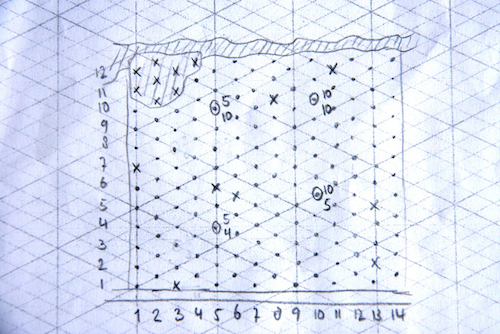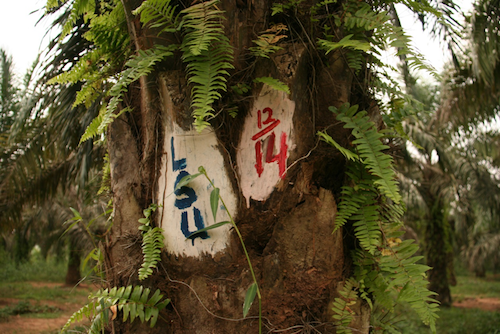Sustainable Oil Palm Farming / Palm marking and leaf sampling
| |
Download: Module 4: Fertiliser Application
Contents
[hide]Background
For keeping track of management and yield it is useful to have a good map of the plantation on which all palms are indicated. On this map, dura and pisifera palms and empty spots should also be marked. In addition, for pest patrols and leaf sample collection it is necessary to select and mark ‘sample palms’, because it is too much work to check or sample all palms. It takes some time to map the field and mark the sample palms, but in the end it will save a lot of time – even if no leaf sampling is done.
Goal
- Be able to monitor management and productivity efficiently;
- Be able to carry out pest patrolling efficiently;
- Be able to carry out leaf sampling effectively.
Standard
- A complete map of the plantation is available, indicating palms, empty spots, and field boundaries;
- A sample of 1–4 percent of the plantation palms is selected;
- Sample palms are healthy and representative of the plantation;
- Sample palms are spread equally throughout the plantation;
- Sample palms are clearly marked.
Timing
- Once, at the start of the rehabilitation process.
Frequency
- Once during the plantation lifetime.
Note: Each time sampling takes place (or once per year) check if the sample palms are still healthy and clearly marked. If not, select another palm and/or refresh the marking
Labour time required
- Drawing a plantation map: 2–3 hours for a field of two hectare.
- Sample palm marking: 1–2 hours per two hectare.
Equipment and materials
- Paintbrush;
- Blue and yellow paint;
- Isometric or other paper (see Figure 27);
- Optional: measuring tape, GPS.
Who
- Farmers and their family or hired labourers.
- Best done together with extension workers or cooperative representatives.
How
Drawing a plantation map
Plantation maps are usually drawn on isometric paper (see Figure 27). Each palm should be indicated with a dot on the intersection of two lines (see Figure 28). If there is no palm, put a cross or leave the spot empty.
Note: If the field is not rectangular, drawing it can be more difficult. Isometric paper will only work when the palms are planted in the correct (triangular) spacing. For rectangular (square) spacing, use simple mathematical paper with squares. For other spacing, draw the plantation on white paper without lines.
To draw a plantation map follow these steps:
| Step 1. | Select the first field to be mapped. |
| Step 2. | Determine the boundaries of the field (e.g. roads, other crops, rivers/streams, oil palm from someone else etc.). |
| Step 3. | Determine the direction of the palm rows:
If the field is not rectangular, try to find the direction of the rows which makes them most easy to count. |
| Step 4. | Draw the palms next to the main road into the map and count the number of rows. |
| Step 5. | For each row, draw in the palms and count the number of palms per row. |
| Step 6. | Indicate streams, rivers, roads and other borders, trying to keep the size correct. Note: Usually a road is one palm row wide (sometimes two). |
Selecting and marking sample palms
To select and mark sample palms follow these steps:
| Step 1. | Select which road will be the main road. |
| Step 2. | Starting in one corner and moving along the road count five rows. At the 5th row:
Note: all palm numbers at the roadside should be ‘1’. |
| Step 3. | Find the direction of the row and follow the row from palm to palm until you get to palm 5. Note: Empty spots also count. |
| Step 4. | At palm 5, check the following:
|
| Step 5. | If the answer to one of the questions is ‘no’, move two palms further into the row and check again. |
| Step 6. | If the answer to all the questions is ‘yes’, mark that palm as described above (in this case: ‘5 over 5’) (see Figure 29). |
| Step 7. | Continue along the row, each time marking the 5th palm (or two palms farther along if the 5th palm doesn’t meet the conditions) until you are two palms from the other end of the field. The palms that are close to the edge of the field (one or two palms away) should not be sampled, because they are not representative (for example, they get more sunlight). |
| Step 8. | Move on to the field boundary |
| Step 9. | Move five rows further along the boundary at the other end. After 5 rows, mark the palm next to the boundary. This should be the 10th row after the start of the field, so the row number on this palm should be 10. The palm number is the number of the last palm in the row.
Note: If the field is not rectangular, it may be necessary to walk back to the beginning of the row and count the number of palms to determine the palm number. |
| Step 10. | Move into the field and repeat step 8–13. |
| Step 11. | Continue until the entire field is done. |
Note: The number of the palms to mark depends on the size of the field. In large fields (5–10 ha) it is better to take every 8th row and every 8th palm. In even larger fields (more than 10 ha) you can take every 10th row and every 10th palms. This is also what companies do.
If the field is not at all rectangular, try to select the palms as follows:
- One palm in 25 (or in 64 or 100 in larger plantations);
- Not the palms less than 2 lines from the boundary;
- At least 4 non-sample palms between the sample palms in each direction.
Acknowledgements
The material from Palm marking and leaf sampling is sourced from Smallholder Oil Palm Handbook and put together by Lotte Suzanne Woittiez (Wageningen Universit) and Haryono Sadikin, Sri Turhina, Hidayat Dani, Tri Purba Dukan, and Hans Smit (SNV) in August 2016. See Module 4: Fertiliser Application for more information.






